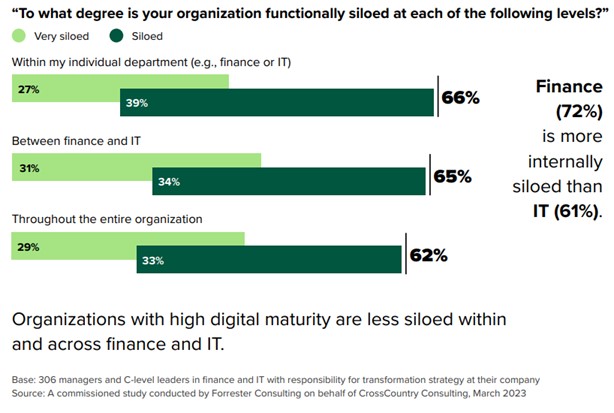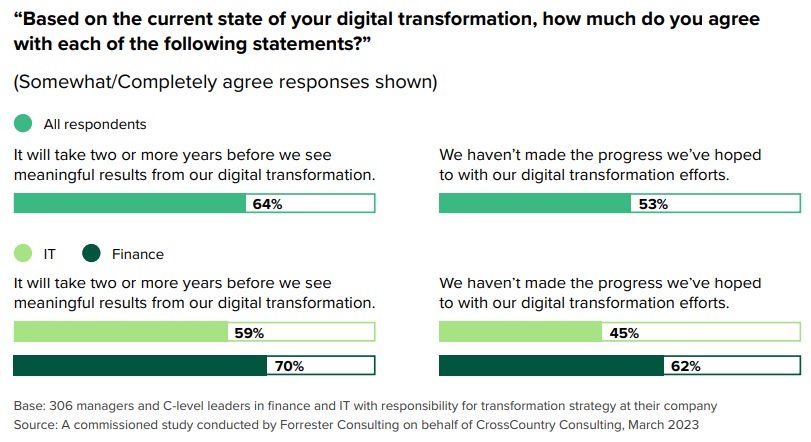The principal barriers to successful digital transformation likely sound frustratingly familiar to today’s top executives. Particularly for CFOs and CIOs – the stewards often tasked with advancing organizational digital maturity – overcoming these challenges is make or break from competitive, strategic, human capital, and budget perspectives.
However, digital investments continue to climb. Progressive technologies like artificial intelligence (AI) and machine learning (ML) redefine once-laborious processes. Employee talent is higher than ever. These advancements are ostensibly moving organizations in the right direction, so why is digital transformation still a puzzle that can’t be solved?
Below are recent findings from a study conducted by Forrester Consulting and commissioned by CrossCountry Consulting that spotlight what’s preventing digital transformation from being effectively implemented and impactful. To move the needle on the velocity, scale, quality, and cost of transformation across an extended enterprise, it starts with fixing what’s broken.
See what 300+ Finance and IT executives say about the state of enterprise digital transformation.
New Forrester research commissioned by CrossCountry Consulting
Persistent Cross-Functional, Cross-Level Silos
The complexity and entrenchment of silos in today’s organizations bog down the business in a web of misalignment, miscommunication, and missed opportunities.
72% of finance leaders say their department is more internally siloed/very siloed compared to 61% of those in IT. Silos are also obstructing alignment at multiple levels throughout organizations, with respondents agreeing that they persist not only between finance and IT (65%) but throughout the entire organization (62%).

Concurrent and overlapping silos exist on more than one axis as well. For example, silos obstruct alignment between departments, within departments, and across the org chart. In other words, finance and IT jointly struggle to synchronize with each other, while both struggle to collaborate internally with their own teams. Inside these silos, too, are often disconnects between staff and management, or management and leadership.
Counterintuitively, just 19% of finance and IT leaders prioritize the removal of these silos as part of their digital transformation roadmaps.
Poor Visibility Through a Lack of Knowledge-Sharing
One of the chief repercussions of organizational silos is poor visibility into operations. Without an established, successful framework for knowledge-sharing across teams, it’s not uncommon for departments and individuals to advance digital transformation for different reasons, with different systems, and at different paces.
When assessed in totality, the organization might then realize it has implemented redundant software or competing processes simply because the left and right hands weren’t speaking.
Absence of Operational Alignment
45% of finance and IT leaders say a lack of operational alignment creates more silos. Had finance and IT, for instance, fostered greater alignment earlier, poor transformation results could’ve been avoided.
Breaking down silos is more than just leveraging the same systems or using the same vocabulary; leaders must commit to removing philosophical and strategic silos that exist at the highest levels of the business.
That means there must be concrete alignment on the corporate vision, the five-year strategy, and other key priorities that impact the entire business and its reason for operating. If leaders have contradictory visions, operational silos will proliferate.
Misunderstanding of End-to-End Processes
The number of touchpoints across business functions expands during transformation. Closer collaboration and integration of workflows, personnel, data, and technologies requires a high-performing process architecture that’s clearly understood and engrained in day-to-day operations.
44% of survey respondents, however, indicate that end-to-end processes – a backbone of digital transformation – aren’t well-understood in their organizations. Opaque rules, roles, and responsibilities make process integrity difficult to maintain over the long run.
Decentralized Communication
While work and work environments are more commonly distributed around the globe today, communication is still a channel that might suffer from further decentralization as it pertains to digital transformation. Decentralized communication (42%) is cited by finance and IT leaders as an accelerant for more silos.
A Center of Excellence (CoE) or steering committee must be a consistent driving force behind digital transformation. If staff hear conflicting priorities or objectives through different channels, it makes transformation all the more difficult to advance.
Disconnected Front and Back Office
Connecting the front and back offices fuels planning, budgeting, reporting, staffing, and various financial and operational activities. But 37% of respondents lack this connection – over time, this disconnect sows different cultures and processes, hampering digital transformation efforts.

Lack of Collaboration
Employees may not naturally have a stimulus to collaborate more closely with other teams or departments, as doing so might lead to more work that doesn’t yield tangible payoffs today. Similarly, if department heads don’t specifically incentivize and enforce greater collaboration, it won’t organically occur on its own. 50% of finance and 38% of IT leaders recognize the absence of critical collaboration as a contributing factor to stalled digital transformation.
Outdated Technology
49% of finance and 40% of IT leaders cite outdated technology as another barrier to digital progress. Decades of custom and legacy software solutions have created an environment in which it’s expensive to retain and maintain existing tech stacks but also expensive to make the jump to entirely new enterprise systems that require years of expenditures in vendors, staff, and training.
The underlying truth is that CFOs and CIOs must partner to make this business case and chart a feasible, cost-effective path forward, even if it upsets decades of tribal knowledge and comfort with systems. Digital transformation can of course occur in stages, but it must begin somewhere, and it will ultimately lead to potentially major technological overhauls.
Lack of Budget
Even if all of the above challenges are addressed, there’s still the cold reality of budget. Depending on the size of the organization, the implementation and maintenance of cloud-based technology solutions won’t be cheap. 46% of finance and 41% of IT leaders say budget constraints hamper their digital transformation efforts – until that budget is secured, real transformation will always be slow-going.
Macroeconomic Uncertainty
Organizational sensitivity to macroeconomic factors like inflation, interest rates, supply chain issues, and labor shortages indefinitely clouds decision-making. CFOs and CIOs – being close to the financial and technological fallout of these factors – must account for these external circumstances on top of the aforementioned internal challenges.
60% of survey respondents indicate they can’t sustain another year of continued macroeconomic uncertainty. Conversely, companies may find this opportunity ripe for strategic investment in cost- and labor-saving technologies, like AI, cloud computing, and robotic process automation (RPA).
Leaders capable of seeing through the fog of hurdles, complexities, and indifference can lead their organizations from the front – toward greater digital maturity and enterprise agility. Kick-starting (or re-kick-starting) digital transformation starts from the top, in full recognition of the roadblocks and opportunities ahead.
For more expert insights on the state of finance and IT’s transformation partnership, download the full study.
